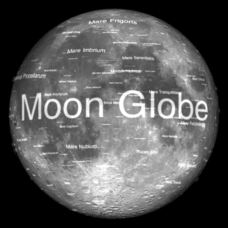Not just a simple globe of the moon, this interactive version allows you to choose lighting according to the location of the sun, views from different positions on Earth, and more! Satellite images and topographic data have been combined to create the views of the moon. Get your lunar lunatics learning with this fascinating application!
Additional Tags
App Overview
Features:
- Relative positions of Earth and the sun appear in the distance
- Rotate the globe with one finger or zoom in and out with two fingers
View Options:
- View from above the globe or as if looking through a telescope from Earth
- Normal, night vision, or red-cyan anaglyph 3-D options for taking the tablet outdoors at night to compare to the actual moon
- Orientation can be north or south, upward, or reversed
- Choose location on Earth from which to view the moon
Labels:
- Can be turned on or off
- Choices include Terrain, Spacecraft, or Distance according to zoomed size
- While in Terrain view, a list of physical features (mostly craters) becomes available, providing information about each and a link to an Internet search
- While in Spacecraft view, a list of all manned and unmanned landings becomes available, providing information about each and links to an Internet search or Wikipedia page
Sky Compass:
- Turn on or off when in Time mode
- Displays moon and sun position in the sky for the chosen date, time, and location
Options:
- Sound effects can be turned on and off
- Compass direction can be turned on and off
- Links to other apps by the same developer
Question Mark at the Top of the Screen:
- Detailed instructions for how to use the app
- Credits
- Internet links to informational websites about the moon
Curator Rating
-
Adherence to task
More than just a lunar map
-
Worth the money
An outstanding free app
-
Fun factor
Like taking a virtual trip to the moon
-
Scaffolding of learning
Detailed instructions provided with a tap
-
User safety
-
Control and feedback
Several different customizable features
-
How techie do I need to be?
Intermediate
Instructional Ideas
Assign some of the more prominent physical landmarks or spacecraft landings to your class to research. Limited information is provided by tapping on the name of the feature, and a link to a Google search.
Using the date feature, have learners identify different phases of the lunar cycle.
Classroom Considerations
Be aware that although the Terrain and Spacecraft features provide the position of the craters and locations of lunar landings, there is no way to turn on lunar latitude and longitude lines.
Pros
- Free; excellent value
- View the moon as you would through a telescope
- View the moon as it would appear on different dates from your location
- Several amazing features
Cons
- Lunar latitude and longitude lines not included


